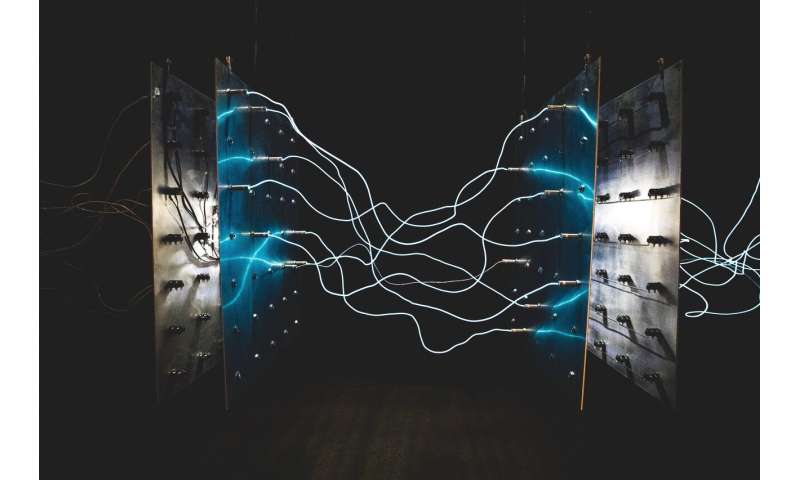New Zealand startup eyes global wireless electrical grid

A startup energy company in New Zealand believes it can power the world with a wireless electric transmission system that can bring power to hard-to-reach areas and do so at lower cost than with traditional power lines.
The startup, Emrod, has teamed up with a leading power supply company to test power transmission using a series of antennas. The only limiting factor is the antennas must be within line of sight with each other.
The system consists of a power source, a transmitting antenna, multiple relay stations, and a receiving antenna, often referred to as a "rectenna."
Emrod converts electric energy into microwaves, which in turn are transmitted through a cylindrical beam to relay stations. Those stations refocus the beam and guide it along its path to the rectennas, where the microwaves are converted back to electricity.
The concept is not new. In fact, futurist, electrical engineer, and inventor Nikola Tesla envisioned a wireless electric system more than 100 years ago. Transcontinental microwave relay networks opened telephone communications between Europe and America in the 1950s, and recent decades have brought us increasingly efficient wireless network and satellite communication technologies.
What makes Emrod's system notable is its high degree of efficiency and near total absence of energy loss.
"The efficiency of all the components we've developed are pretty good, close to 100 percent," said Emrod founder Greg Kushnir. He said his system uses many of the same elements as the common household microwave oven, which achieves only a 70 percent efficiency. The development of newer materials for energy transmission in recent years helps to minimize energy loss, he said.
"We're not the first [to apply this technology], but we're the first ones to have a commercially viable solution," Kushnir said.
Emrod has tested the system over short distances, up to 130 feet so far. Company officials say there is no reason to believe the system will not work perfectly over hundreds miles. Offshore facilities could transmit power to hard-to-reach destinations. Power could be transmitted easily through mountainous regions or areas that would be too treacherous or too costly to lay traditional wiring through. Wireless power stations could be set up quickly in the aftermath of hurricanes or other natural disasters.
"We can use the exact same technology to transmit 100 times more power over much longer distances," Kushnir said. "Wireless systems using Emrod technology can transmit any amount of power current wired solutions transmit."
Could wildlife, such as birds, get zapped by the microwave beams? Emrod officials say a protective ring of laser beams acting as bodyguards around the microwave transmissions will shut off the beams when objects such as birds, other animals or humans, approach. The momentary outages should not affect overall power transmission. Facilities using sensitive equipment, such as medical devices, would need to have battery backups for the occasional power interruptions where stoppages of even just seconds could be critical.
Besides, the power density is low. "It's not just how much power you deliver, it's how much power you deliver per square meter," Kushnir said. "The levels of density we're using are relatively low. At the moment, it's about the equivalent of standing outside at noon in the sun, about 1 kW per square meter."
He says bad weather or adverse atmospheric conditions will have no impact on transmission. Should there be a failure in transmission, mobile stations attached to trucks could be dispatched relatively quickly.
"We have an abundance of clean hydro, solar, and wind energy available around the world but there are costly challenges that come with delivering that energy using traditional methods," Kushnir said. "I wanted to come up with a solution to move all that clean energy around from where it's abundant to where it's needed, in a cost-effective, eco-friendly way."
"Energy generation and storage methods have progressed tremendously over the last century but energy transmission has remained virtually unchanged" for 150 years, he said.
The joint project with Powerco will begin in October. The company also has plans to beam power across 19 miles of water from the New Zealand mainland to Stewart Island, at what is expected to be nearly half the cost of a traditional wired system.
© 2020 Science X Network
No comments:
Post a Comment